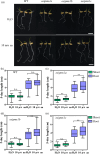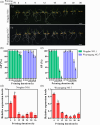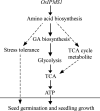Influence of isopropylmalate synthase OsIPMS1 on seed vigour associated with amino acid and energy metabolism in rice
- PMID: 29947463
- PMCID: PMC6335077
- DOI: 10.1111/pbi.12979
Influence of isopropylmalate synthase OsIPMS1 on seed vigour associated with amino acid and energy metabolism in rice
Abstract
Seed vigour is an imperative trait for the direct seeding of rice. Isopropylmalate synthase (IPMS) catalyses the committed step of leucine (Leu) biosynthesis, but its effect on seed vigour remains unclear. In this study, rice OsIPMS1 and OsIPMS2 was cloned, and the roles of OsIPMS1 in seed vigour were mainly investigated. OsIPMS1 and OsIPMS2 catalyse Leu biosynthesis, and Leu feedback inhibits their IPMS activities. Disruption of OsIPMS1 resulted in low seed vigour under various conditions, which might be tightly associated with the reduction of amino acids in germinating seeds. Eleven amino acids that associated with stress tolerance, GA biosynthesis and tricarboxylic acid (TCA) cycle were significantly reduced in osipms1 mutants compared with those in wide type (WT) during seed germination. Transcriptome analysis indicated that a total of 1209 differentially expressed genes (DEGs) were altered in osipms1a mutant compared with WT at the early germination stage, wherein most of the genes were involved in glycolysis/gluconeogenesis, protein processing, pyruvate, carbon, fructose and mannose metabolism. Further analysis confirmed that the regulation of OsIPMS1 in seed vigour involved in starch hydrolysis, glycolytic activity and energy levels in germinating seeds. The effects of seed priming were tightly associated with the mRNA levels of OsIPMS1 in priming seeds. The OsIPMS1 might be used as a biomarker to determine the best stop time-point of seed priming in rice. This study provides novel insights into the function of OsIPMS1 on seed vigour and should have practical applications in seed priming of rice.
Keywords: Oryza sativa; isopropylmalate synthase; seed priming; seed vigour.
© 2018 The Authors. Plant Biotechnology Journal published by Society for Experimental Biology and The Association of Applied Biologists and John Wiley & Sons Ltd.
Conflict of interest statement
The authors declare no conflict of interest.
Figures











Similar articles
-
Indole-3-acetate beta-glucosyltransferase OsIAGLU regulates seed vigour through mediating crosstalk between auxin and abscisic acid in rice.Plant Biotechnol J. 2020 Sep;18(9):1933-1945. doi: 10.1111/pbi.13353. Epub 2020 Feb 15. Plant Biotechnol J. 2020. PMID: 32012429 Free PMC article.
-
A genome-wide association study reveals that the 2-oxoglutarate/malate translocator mediates seed vigor in rice.Plant J. 2021 Oct;108(2):478-491. doi: 10.1111/tpj.15455. Epub 2021 Aug 22. Plant J. 2021. PMID: 34376020
-
Genome-wide association study reveals that the cupin domain protein OsCDP3.10 regulates seed vigour in rice.Plant Biotechnol J. 2022 Mar;20(3):485-498. doi: 10.1111/pbi.13731. Epub 2021 Oct 31. Plant Biotechnol J. 2022. PMID: 34665915 Free PMC article.
-
Early seedling vigour, an imperative trait for direct-seeded rice: an overview on physio-morphological parameters and molecular markers.Planta. 2015 May;241(5):1027-50. doi: 10.1007/s00425-015-2273-9. Epub 2015 Mar 25. Planta. 2015. PMID: 25805338 Review.
-
Efficient use of energy in anoxia-tolerant plants with focus on germinating rice seedlings.New Phytol. 2015 Apr;206(1):36-56. doi: 10.1111/nph.13173. Epub 2014 Dec 4. New Phytol. 2015. PMID: 25472708 Review.
Cited by
-
Identification of novel candidate loci and genes for seed vigor-related traits in upland cotton (Gossypium hirsutum L.) via GWAS.Front Plant Sci. 2023 Sep 1;14:1254365. doi: 10.3389/fpls.2023.1254365. eCollection 2023. Front Plant Sci. 2023. PMID: 37719213 Free PMC article.
-
Indole-3-acetate beta-glucosyltransferase OsIAGLU regulates seed vigour through mediating crosstalk between auxin and abscisic acid in rice.Plant Biotechnol J. 2020 Sep;18(9):1933-1945. doi: 10.1111/pbi.13353. Epub 2020 Feb 15. Plant Biotechnol J. 2020. PMID: 32012429 Free PMC article.
-
Advances in the Identification of Quantitative Trait Loci and Genes Involved in Seed Vigor in Rice.Front Plant Sci. 2021 Jul 14;12:659307. doi: 10.3389/fpls.2021.659307. eCollection 2021. Front Plant Sci. 2021. PMID: 34335643 Free PMC article. Review.
-
Characteristics of Seed Vigor in Rice Varieties with Different Globulin Accumulations.Int J Mol Sci. 2022 Aug 26;23(17):9717. doi: 10.3390/ijms23179717. Int J Mol Sci. 2022. PMID: 36077115 Free PMC article.
-
Integrative QTL Identification, Fine Mapping and Candidate Gene Analysis of a Major Locus qLTG3a for Seed Low-Temperature Germinability in Rice.Rice (N Y). 2021 Dec 15;14(1):103. doi: 10.1186/s12284-021-00544-2. Rice (N Y). 2021. PMID: 34910270 Free PMC article.
References
-
- Abe, A. , Takagi, H. , Fujibe, T. , Aya, K. , Kojima, M. , Sakakibara, H. , Uemura, A. et al. (2012) OsGA20ox1, a candidate gene for a major QTL controlling seedling vigor in rice. Theor. Appl. Genet. 125, 647–657. - PubMed
-
- Angelovici, R. , Fait, A. , Fernie, A.R. and Galili, G. (2011) A seed high‐lysine trait is negatively associated with the TCA cycle and slows down Arabidopsis seed germination. New Phytol. 189, 148–159. - PubMed
-
- Araújo, W.L. , Ishizaki, K. , Nunes‐Nesi, A. , Larson, T.R. , Tohge, T. , Krahnert, I. , Witt, S. et al. (2010) Identification of the 2‐hydroxyglutarate and isovaleryl‐CoA dehydrogenases as alternative electron donors linking lysine catabolism to the electron transport chain of Arabidopsis mitochondria. Plant Cell, 22, 1549–1563. - PMC - PubMed
-
- Araújo, W.L. , Tohge, T. , Ishizaki, K. , Leaver, C.J. and Fernie, A.R. (2011) Protein degradation ‐ an alternative respiratory substrate for stressed plants. Trends Plant Sci. 16, 489–498. - PubMed
Publication types
MeSH terms
Substances
Grants and funding
- 31771889/National Natural Science Foundation of China/International
- 2018YFD0100901/National Key Research and Development Plan/International
- 2017KTSCX024/Major Scientific Research Projects of General Colleges and Universities of Guangdong Province/International
- BK20161451/Natural Science Foundation of Jiangsu Province/International
- BK20150675/Natural Science Foundation of Jiangsu Province/International
LinkOut - more resources
Full Text Sources
Other Literature Sources

